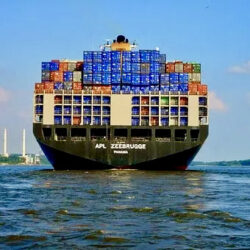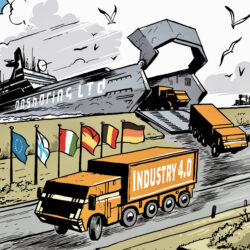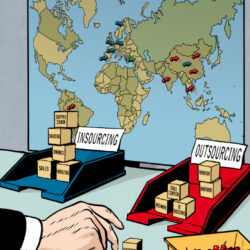Standardization paves the way for digitization of container transport

The transport of a single container can easily involve 30 different stakeholders and up to 50 sheets of paper. Digitizing the industry will not only save a lot of paper, but also billions of dollars in costs. During a recent Webinar Wednesday, Dave van Diggele of the Digital Container Shipping Association explained the benefits of a digital Bill of Lading: “For most parties, digitization of container transport is a no-brainer.”
By Marcel te Lindert
The Digital Container Shipping Association (DCSA) was founded in 2019 by nine of the world’s 10 largest container shipping companies. The non-profit organization, which is headquartered in Amsterdam, is developing new standards that will help accelerate digitization in container shipping. DCSA is not building a platform itself, but rather facilitating the use of relevant platforms in the container industry. “It’s similar to the way that everyone is free to select their own platform for e-mail, such as Outlook, Gmail and the like. It’s thanks to the underlying standards that all those platforms can work with each other and exchange e-mails,” said Van Diggele, Programme Lead Shippers at DCSA.
Digital Bill of Lading
In the container industry, everything revolves around the Bill of Lading. This document is prepared by the container shipping company and sent to the cargo owner at the moment that the goods are loaded. The cargo owner must then present the Bill of Lading upon the container ship’s arrival in order to claim the goods. Van Diggele: “I think everyone in this world knows about the enormous amount of paperwork involved in container shipping. If we switch to only using an electronic Bill of Lading (eBL), it will save a lot of trees.”
The financial benefits are even more persuasive than the environmental benefits. McKinsey has calculated that the use of the eBL can free up US$18 billion in the container industry by speeding up administrative processes and reducing human errors. Moreover, because digitization reduces supply chain friction, the container industry revenue is estimated to grow by US$30 billion to US$40 billion. Besides container shipping companies, Van Diggele also works with financial institutions: “They too see the financial benefits of digitization and are interested in innovation.”
Nearshoring
To explore the opportunities offered by digital standards, Supply Chain Media and DCSA worked together to create a mindmap and started by identifying the global trends. One key trend is nearshoring. “We talk to a lot of manufacturing companies that want to produce closer to their sales market,” Van Diggele explained. “If you ship a container from Southeast Asia to Europe, it takes at least five weeks to arrive, which is normally long enough for all the paperwork to be completed. Now that companies are nearshoring their production activities, the container journey might only take a week. That requires faster handling of paperwork and therefore digitization.”
Additionally, the mindmap shows the impact of the trends on the various stakeholders in the container industry. DCSA interacts with all of them. “First of all, we have a lot of contact with authorities and institutions working on standards. If suitable standards are already available, there’s no need for us to develop new ones. In addition, we talk to cargo owners and freight forwarders who are facing rising costs and higher risks. They too have a need for standards so that systems can be integrated,” Van Diggele said.
50 sheets of paper
Another important group of stakeholders are the IT vendors who are already using a variety of technologies to exchange hundreds of thousands of eBLs. “Last but not least, we are in touch with a lot of other parties, such as port authorities, customs authorities and container terminals. They all have an interest in standardization and digitization.”
However, the path to achieving this is not without obstacles. In some cases, the transport of a single container is accompanied by 50 sheets of paper displaying numerous stamps and signatures. “It’s not only about the Bill of Lading, but also about many other documents that are handled in the traditional way. Up to 30 different parties can be involved. For most of them, digitization is a no-brainer,” he continued.
A single digital data source
The Seaway Bill (SWB) is one document that is often already exchanged digitally. “Even parties that only use SWBs rather than BLs will also benefit from standardization. Most SWBs are only available as PDFs and are transmitted manually. By fully digitizing these documents, we create a single digital data source that gives all parties throughout the chain direct access to the data relevant to them,” stated Van Diggele. “We see that the youngest generation in particular no longer wants to work with paper. Young people want to use digital standards rather than having to print out and sort documents. Digitization helps to retain that talent in the industry.”
Among other things, the last part of the mindmap covers the standards to be used. Currently, companies are still using a variety of EDI links, plus they have integrations with ports’ and container terminals’ systems. “There are too many different data standards around, which makes it difficult to create transparency. So let’s make smart use of the data standards that are available and deploy standard API links when standards are not yet available,” Van Diggele recommended.
eBL Declaration
DCSA is developing standards at three levels. One team is working on standards for optimal deployment of container ships, while another team is working on standards that, among other things, enable real-time tracking and tracing of containers. A third team is working on standards for digital commerce for things like booking a container and creating eBLs. “Those standards will make it easier to connect all stakeholders’ systems, irrespective of whether they are ERP systems, transportation management systems or other systems.”
A large number of parties have now committed to the mission to fully digitize the Bill of Lading. Van Diggele mentioned the Future International Trade Alliance and the eBL Declaration, which has been signed by more than 80 shippers, carriers, banks and other parties. “They are the frontrunners,” stated Van Diggele. “It all starts with this digital Bill of Lading, but that’s really just the first step toward complete digitization of the container industry.”










